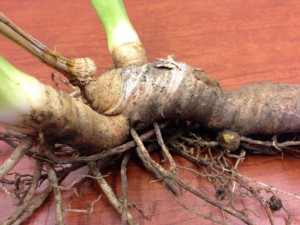Whether you’re looking to expand your planting of iris or just need to rejuvenate an older planting, late summer through early fall is a good time to lift and divide iris. Dividing every three to five years will help rejuvenate the planting, and encourage more blossoms for the subsequent years.
Most iris plants spread by means of underground stems called rhizomes. Rhizomes become too crowded over time, resulting in reduced flowering. By lifting and dividing the larger clumps, you can rejuvenate the old planting, as well as provide a source of new plants to expand your garden or share with friends.
Dig the clumps by inserting a spade around the circumference of the planting. Then insert the spade beneath the clump and lift. Deep spading should not be necessary as iris rhizomes and roots are rather shallow.
Use a sharp knife to cut the younger, outward-growing rhizomes into sections, leaving as many roots and buds on each piece as possible. For ease in replanting, cut the leaves to one-third their original height. Discard the old central portions of the original rhizome, as well as any sections that appear to be diseased or infested with iris borer.
Replant the newly cut sections as soon as possible to avoid excessive drying. Planting depth is important, and this is where most gardeners make their mistake. Iris rhizomes should be placed just below the soil surface with the roots pointing down and the cut leaves upright and exposed to the sun. Firm the soil and water gently and thoroughly. Newly set plants will likely require weekly watering until they establish a new root system.

